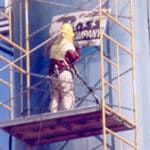Anti Corrosion Painting
Anti-corrosion painting is done to protect surfaces from the harmful effects of corrosion that can lead to a drastic reduction in the life of joints and welds and weaken the surface due to increased wear. When steel and other metallic materials are exposed to corrosive environments, i.e., in levels of increased humidity, a number of chemical reactions occur between the exposed surface and the water present in the atmosphere. This leads to the slow corrosion of the exposed surface that slowly extends to the interior of the structure. The formation of rust on the surface of the steel is a form of corrosion. Corrosion can have severe consequences on machinery or structures that are strong, safe, and dependable and are used every day. It usually results in the need to replace parts or, in extensive cases, the entire machine, even if the extent of corrosion isn’t large in magnitude. It’s quite obvious that corrosion is harmful to the surface and strength of a structure, which is why a number of steps are taken to prevent corrosion from occurring.
These days, the problem of corrosion has been reduced quite drastically due to a maximum number of buildings being temperature controlled, which ensures that the level of humidity is low and does not affect or react with the steel and other metal joints and links present in the structure. However, the external elements of a structure are still susceptible to corrosion, as they are openly exposed to the environment and all its effects, which is why anti-corrosion methods are important to ensure the protection of the structural elements. Corrosion of a structure can either be due to exposure to weather, rain, snow, etc. or by aggressive environments like structures that enclose swimming pools, car washes, water treatment plants, etc. When corrosion is caused by exposure to weather, the magnitude of exposure is a big factor that determines the effect of weather and the extent of corrosion that would take place.
Anti-corrosion protection is most widely done by coating the surface to prevent contact between the structure and the surrounding environment. Protective coatings are classified into two broad categories – metallic coatings and non-metallic coatings. The type of coating used generally depends on the nature of the surface to be protected. Other factors like usage, the extent of exposure, expenditure set aside for anti-corrosion protection, etc., also affect the selection of the coating to be used. In general, metallic coatings are more expensive. They are used in cases where there are extensive corrosion-causing factors, like in the case of external structures where the metal is almost permanently exposed to the environment, leading to constant fear of corrosion. But, metallic coatings are also more permanent than other forms of anti-corrosion protection. They are, therefore, not required to be re-applied as regularly as other coatings and, in the long run, prove to be more cost-effective.
Painting is one of the most commonly used methods of corrosion resistance. It is a form of non-metallic coating. By applying a layer of paint to the surface that is exposed to the elements, a protective layer is formed that prevents the steel or metal underneath from coming in contact with moisture and humidity, which, in turn, ensures that no chemical reactions take place and there is no rusting. Painting a surface provides a barrier of corrosion-resistant material between the structure and the damaging environment, thus reducing the harmful effects. Depending on the nature of the structure, whether it is steel, iron, or any other metal, there are different kinds of anti-corrosion paints available.
Each has different properties, like alkali, salt, or acid properties. In general, pain coatings are not as expensive as metallic coatings and have the added advantage of being easy to apply. However, they are not as permanent as metallic coatings and have to be reapplied quite frequently. Before protective paint can be applied to prevent corrosion, an inspection of all factors surrounding the structure is carried out. This is done to determine the kind of paint to be used as well as the painting process that would be best to ensure complete coverage of the entire surface with the anti-corrosion paint.
By taking care during the inspection process, savings can be increased as it is during this step that almost all decisions are made that would ensure proper anti-corrosion of the surface, and this, in turn, increases the life of the structure and helps reduce costs of replacements or damage repair in case of corrosion. Depending on the type of joints, exposure, etc., it is decided what type of paint would be most effective in preventing corrosion and the painting process, whether the pain should be sprayed on or immersion should be done to ensure that the anti-corrosion paint completely covers the exposed surface.













